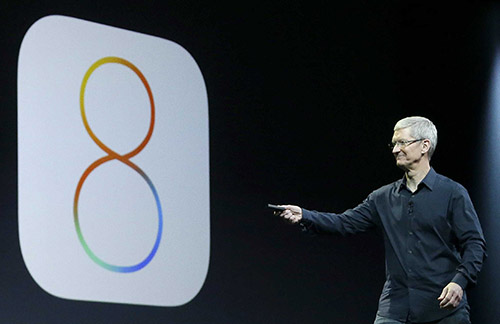07.10.2014Less than half of the Apple devices visiting the App Store are running iOS 8

There are a lot of new desirable consumer-facing features in iOS 8, but it appears that iPhone and iPad users aren’t upgrading to the new version at the same rate Apple has enjoyed before. According to Apple’s own stats on its developer site, only 47 percent of iOS devices visiting the App Store are running iOS 8, which appears to be down from last year’s iOS 7 launch, which saw uptake around 60 percent after three weeks.
Sure, having nearly half of devices running the latest OS after a few weeks isn’t shabby at all, especially compared to Android, which only has about a quarter of devices running Android 4.4 KitKat (although Google does have the vast majority of devices running Android on the latest Google Play Services, which is how important updates and new features get sent out.) But Apple loves to tout that its users actually like to upgrade to newer software, and it looks like adoption is a lot slower for iOS 8.
Why aren’t people upgrading? Well, it could be a function of device mix: There could be a lot of iPhone 4 users out there stuck on iOS 7 since the new iOS 8 doesn’t support those old phones. It could also be a quirk of the updating process. Often, users saw estimated download times of more than a day, which could have led them to figure they’d download it later and then ended up never going back to do so.
But this most recent iOS 8 rollout has been the buggiest in memory, partially due to Apple’s new annual cycle for upgrading both OS X and iOS. There were serious bugs when iOS 8 first launched, and then after that was a disastrous 8.0.1 update which cut cell service an estimated 40,000 iPhones. Apps are crashing more often than they used to. The banner iOS 8 feature, Continuity, won’t be available until Apple launches the latest version of its desktop operating system which is expected later this month. With issues like that, many people may have decided to wait until it looks like the update is more stable.
But the simplest explanation may be that consumers weren’t given a clear reason to update. With iOS 7, the pitch was easy: Your iPhone’s interface will look different and you will get a handy shortcut tray. iOS 8 has a lot of cool new features, but they’re harder to sum up in a sentence. Apple might need a better draw than notification center widgets or alternative keyboards to get millions of people to take time out of their day and download a 2GB software update.
back
 There are a lot of new desirable consumer-facing features in iOS 8, but it appears that iPhone and iPad users aren’t upgrading to the new version at the same rate Apple has enjoyed before. According to Apple’s own stats on its developer site, only 47 percent of iOS devices visiting the App Store are running iOS 8, which appears to be down from last year’s iOS 7 launch, which saw uptake around 60 percent after three weeks.
There are a lot of new desirable consumer-facing features in iOS 8, but it appears that iPhone and iPad users aren’t upgrading to the new version at the same rate Apple has enjoyed before. According to Apple’s own stats on its developer site, only 47 percent of iOS devices visiting the App Store are running iOS 8, which appears to be down from last year’s iOS 7 launch, which saw uptake around 60 percent after three weeks.